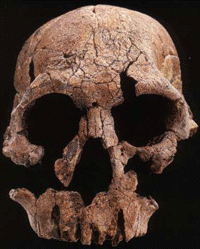

 Skull KNM-ER 1470 | This fossil was discovered by Bernard Ngeneo in 1972 at Koobi Fora in Kenya and its estimated age is approximately 1.9 million years. The cranial capacity of the find is 750 cc. Originally, due to faulty dating, it was put at close to 3 million years old, which caused a problem since it was thought to be a H. habilis descended from the australopithecines, which would have been temporally impossible. Recently scientists classified the skull as H. rudolfensis rather than H. habilis. The distinction was made because Homo rudolfensis had a flatter, broader face and broader postcanine teeth with thicker enamel. This species also had a larger brain and more modern cranium. Therefore, the two species of Homo, H. habilis and H.rudolfensis, coexisted 2 million years ago. It is debatable which gave rise to later Homo. |
|
Homo habilis |
Homo rudolfensis |
|
|
Height |
1.0 metres |
Ca. 1.5 metres |
|
Physique |
Relatively long arms |
Robust, but "human" skeleton |
|
Cranial Volume |
500 � 650 cc |
600 � 800 cc |
|
Known Date |
2.0 � 1.6 million years ago |
2.4 � 1.6 million years ago |
|
Distribution |
Eastern (+Southern?) Africa |
Eastern Africa |
|
Skull form |
Relatively small face; nose developed |
Larger, flatter face |
|
Jaws/Teeth |
Thinner jaw; smaller, narrow molars |
Robust jaw; large narrow molars |
In many ways the braincase is very similar to modern humans, and it is less robust than the other australopithecine skulls. There are indications of the ability for language in the cerebral asymmetry of the skull, making it, albeit disputed, the earliest example of a species with lateralization. It shows evidence of Broca's Area as a lump in the front left side of the skull and this has implications for language acquisition, development, and perception.
Images:
http://www.liv.ac.uk/HumanAnatomy/hprg/images/habilis.gif
http://www.liv.ac.uk/HumanAnatomy/hprg/images/habilis2.gif
http://www.humanevolution.f2s.com/er1470.html

.